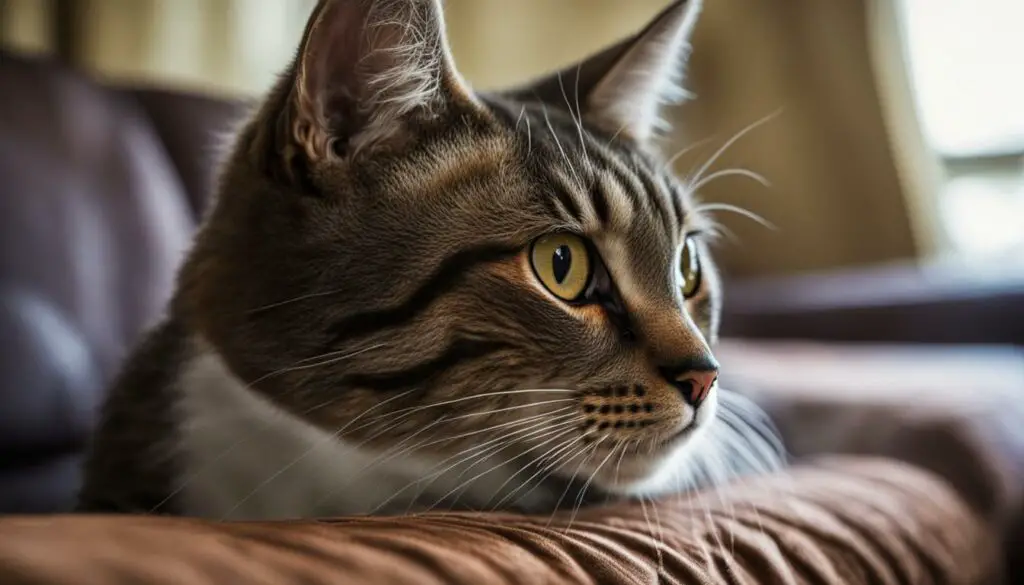Have you ever wondered why your cat gets a sudden burst of energy and starts scratching as soon as you walk through the door? It’s a common behavior among our feline friends, and there are a few reasons behind it.
Cat scratching is a natural behavior that serves several purposes. It’s not just about sharpening their claws or destroying your furniture. Cats scratch for a variety of reasons, including marking their territory, maintaining nail hygiene, exercising their muscles, and even releasing anger.
When you come home, your cat may run straight to their scratching post, eager to communicate their excitement and happiness. Understanding the reasons behind this behavior can help you better understand and respond to your cat’s needs.
Key Takeaways:
- Cats scratch for various reasons, such as marking their territory, maintaining nail hygiene, exercising their muscles, and releasing anger.
- Scratching can be a way for cats to communicate their excitement and happiness when you come home.
- Understanding why your cat scratches can help you provide suitable alternatives and strengthen your bond with them.
- Redirecting inappropriate scratching involves providing appropriate scratching options and avoiding punishment.
- Observing where your cat scratches can help you strategically place scratching posts and encourage them to use them instead.
Why Do Cats Scratch?
Cats scratch for various important reasons, such as marking their territory, maintaining nail hygiene, exercising their muscles, and releasing anger. It is a natural behavior that serves several purposes for cats.
When it comes to marking their territory, scratching plays a crucial role. By scratching, cats leave scratch marks and a unique smell produced by their sweat and scent glands. This helps them communicate with other cats and feel at home in their environment.
In addition to marking territory, cats scratch to maintain their nail hygiene. When they scratch, they remove the outer husk of their claws, allowing a new, sharp layer to emerge. Scratching also trims their nails and helps them check for any diseases or injuries in the claw area.
Scratching is also a form of exercise for cats. When they scratch, they stretch their forelimbs and spine muscles, promoting muscle strength and flexibility. It is important to provide a scratching post that is strong and sturdy enough for your cat’s weight to encourage proper exercise.
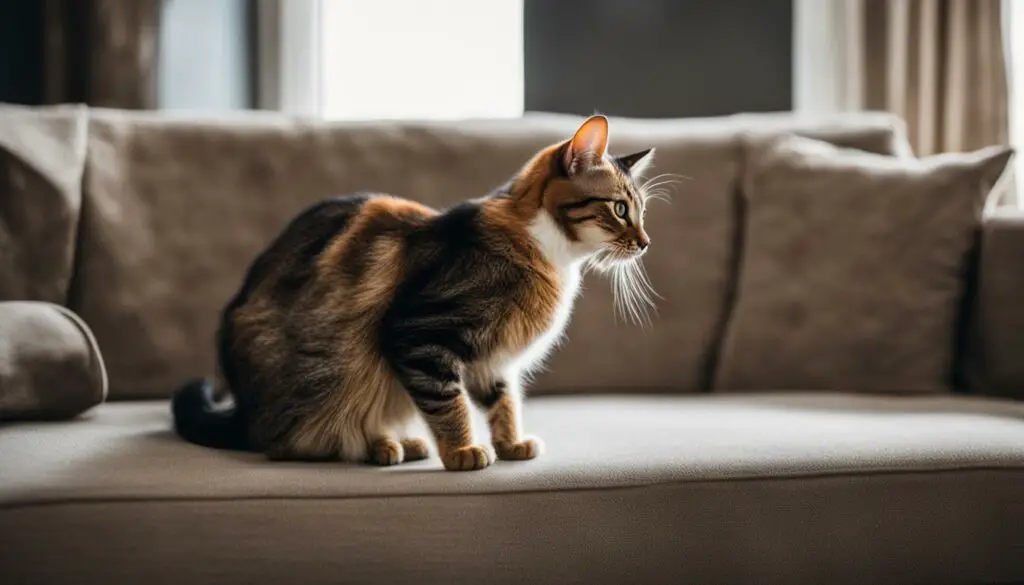
Lastly, scratching serves as a way for cats to release anger and tension. Some cats use scratching as a means to channel their emotions and communicate their feelings to their owners. It is important to understand these behaviors and provide suitable alternatives for your cat to scratch in order to redirect their behavior and ensure a harmonious relationship.
To Mark Their Territory
When it comes to cat scratching behavior, one of the main reasons behind it is marking territory. Cats have a strong instinct to establish their presence and communicate with other cats in their environment. Scratching allows them to leave signature scratch marks and a unique smell that is produced by their sweat and scent glands.
By scratching, cats create visible and olfactory marks that serve as a message to other cats, indicating that a particular area has been claimed. These scratch marks act as territorial boundaries, helping cats establish a sense of ownership and security in their surroundings. It’s their way of saying, “This space is mine!”
It is important to understand that scratching for territorial marking is a natural behavior for cats and a vital part of their communication system. Providing your cat with appropriate scratching surfaces and allowing them to mark their territory in a controlled manner can help fulfill their innate instinct and promote a harmonious environment for everyone.
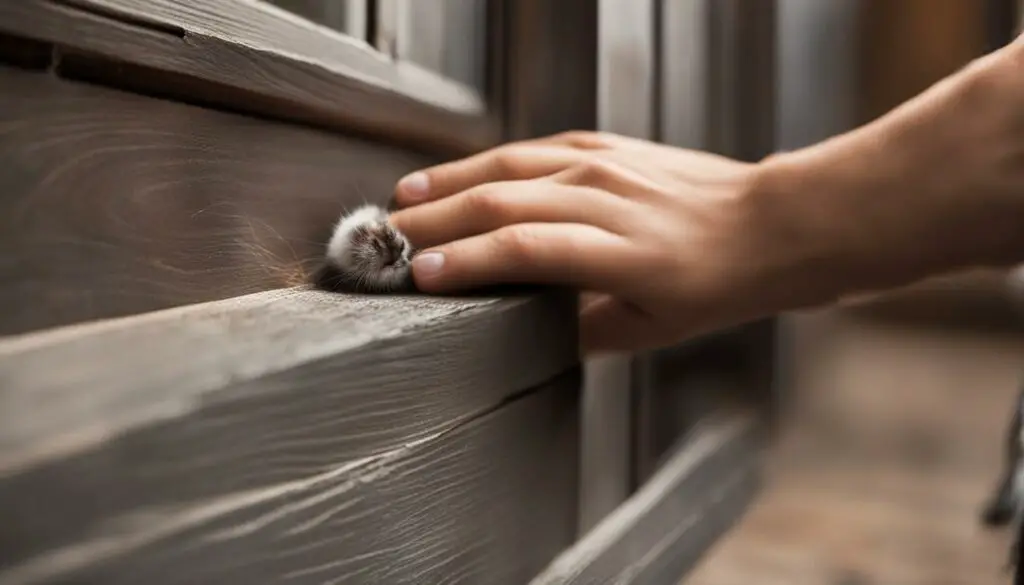
Scratching is a way for cats to mark their territory and establish a sense of ownership and security in their surroundings.
Signature Scratch Marks and Unique Smell
| Behavior | Description |
|---|---|
| Scratching | Leaves signature scratch marks |
| Scent marking | Produces a unique smell |
In summary, cats scratch to mark their territory and communicate with other cats. Scratching allows them to leave signature scratch marks and a unique smell that acts as territorial boundaries. Understanding and accommodating this natural behavior can help create a positive and enriching environment for your feline friend.
Why Do Cats Scratch?
Cats have a natural instinct to scratch, and it serves various purposes, including maintaining their nail hygiene. When cats scratch, they remove the outer husk of their claws, allowing a new, sharp layer to emerge. This helps to keep their claws in good condition and prevents them from becoming too long or overgrown. Scratching also trims their nails, which is important for their overall health and comfort.
In addition to maintaining nail hygiene, scratching provides cats with an opportunity to check for any diseases or injuries in the claw area. By scratching, they are able to inspect their claws and paws, ensuring everything is in order. This self-grooming behavior helps cats to stay healthy and catch any potential issues early on.
To encourage appropriate scratching behavior, it’s important to provide your cat with suitable alternatives, such as scratching posts or mats. These should be sturdy and placed in strategic locations where your cat likes to scratch. By offering them an enticing scratching surface, you can redirect their behavior away from your furniture or other inappropriate objects.
| Benefit | Explanation |
|---|---|
| Maintaining Nail Hygiene | Scratching removes the outer husk of claws, allowing a new layer to emerge |
| Trimming Nails | Scratching helps cats naturally trim their nails |
| Checking for Diseases or Injuries | Scratching allows cats to inspect their claws and paws |
Remember, it’s important to approach your cat’s scratching behavior with patience and understanding. Punishing or scolding them for inappropriate scratching can lead to stress and anxiety, which may exacerbate the problem. Instead, provide them with positive reinforcement when they use their designated scratching surfaces and redirect them when necessary. With consistent training and the right scratching options, you can help your cat maintain their nail hygiene while protecting your belongings.
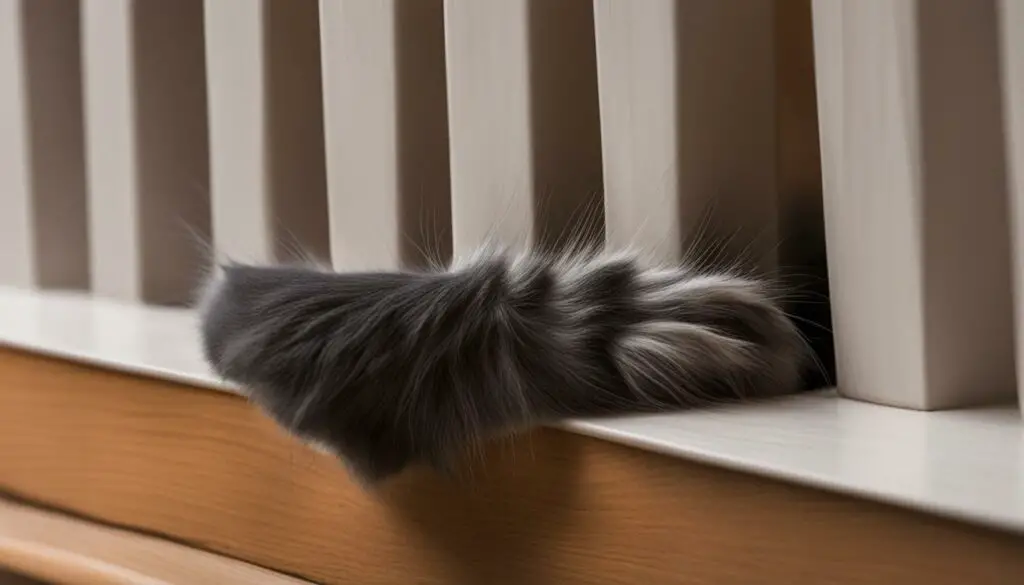
To Exercise Their Muscles
Another important reason why cats scratch is to exercise their muscles. When cats scratch, they engage their forelimbs and spine muscles, promoting muscle strength and flexibility. It’s like a mini workout for them! This natural behavior allows cats to stretch their muscles and keep them in good shape.
Scratching also helps cats release built-up energy and relieve any tension or stress they may be feeling. By scratching, they can channel their natural instinct to move and exercise. Providing a sturdy scratching post or mat can encourage your cat to engage in this beneficial exercise.
When choosing a scratching post for your cat, make sure it is tall enough for them to fully stretch their bodies. Look for a post with different textures or materials so your cat can choose what feels best for them. Placing the scratching post near their favorite sleeping spot or in areas where they tend to scratch the most can also help redirect their scratching behavior.
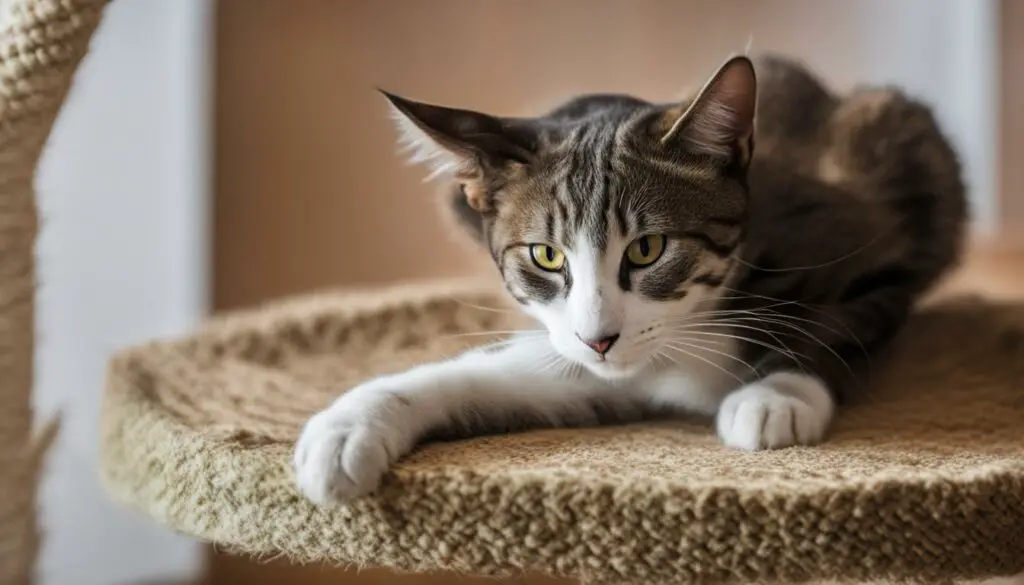
Benefits of Exercise for Cats
- Improves muscle tone and strength
- Helps maintain a healthy weight
- Enhances flexibility and agility
- Provides mental stimulation
- Reduces the risk of obesity-related health issues
Regular exercise is important for cats of all ages. By providing them with opportunities to scratch and stretch their muscles, you can help keep them happy, healthy, and satisfied.
To Release Anger
When it comes to cat scratching behavior, it’s important to understand that scratching can serve as a way for cats to release anger, tension, and anxiety. Cats, just like humans, experience a range of emotions, and scratching can be a natural instinctual response to these emotions. By engaging in scratching, cats are able to channel their feelings and communicate their emotions to their owners in a non-verbal way.
Scratching as a means to release anger is not uncommon in cats. If your cat is feeling frustrated or irritated, they may resort to scratching as a way to cope with these emotions. It’s important to remember that scratching in these situations is not a reflection of personal vendetta against you, but rather a way for your cat to express their displeasure or dissatisfaction. By providing appropriate outlets for their emotions, such as scratching posts or designated scratching areas, you can help redirect their behavior and prevent damage to furniture or belongings.
“Cats, just like humans, experience a range of emotions, and scratching can be a natural instinctual response to these emotions.”
Tension and anxiety can also lead to increased scratching behavior. If your cat is feeling stressed or anxious, they may use scratching as a way to relieve their tension and calm themselves down. By scratching, they are able to release pent-up energy and redirect their focus, helping them feel more grounded and in control. Providing a safe and calm environment for your cat, along with other stress-reducing strategies such as interactive play and ample hiding spots, can help alleviate their anxiety and reduce excessive scratching.
Overall, understanding that scratching can be a means for cats to release anger, tension, and anxiety is crucial in responding to their behavior effectively. By acknowledging their emotions and providing appropriate outlets for their scratching needs, you can create a harmonious and understanding relationship with your feline companion.

Why Do Cats Run to Scratch Once I Get Home?
When you come home, have you noticed that your furry feline friend immediately dashes towards their scratching post? It’s a common behavior in cats, but have you ever wondered why they do it? While there isn’t extensive scientific research on this specific behavior, experts believe that cats run to scratch as a way to communicate their excitement and happiness.
Scratching is a natural behavior for cats, and it serves several purposes. It helps them mark their territory, maintain nail hygiene, exercise their muscles, and even release anger or tension. When you come home, your cat’s excitement may be overflowing, and running towards the scratching post allows them to express their joy and communicate their positive emotions towards you.
So, the next time you witness your cat’s swift dash towards their scratching post when you arrive home, remember that it’s their way of saying, “I’m so happy to see you!” Embrace their enthusiasm and consider joining in the excitement by engaging in playtime or providing them with affectionate attention. Understanding and responding to your cat’s scratching behavior can strengthen your bond and create a harmonious relationship between you and your beloved pet.
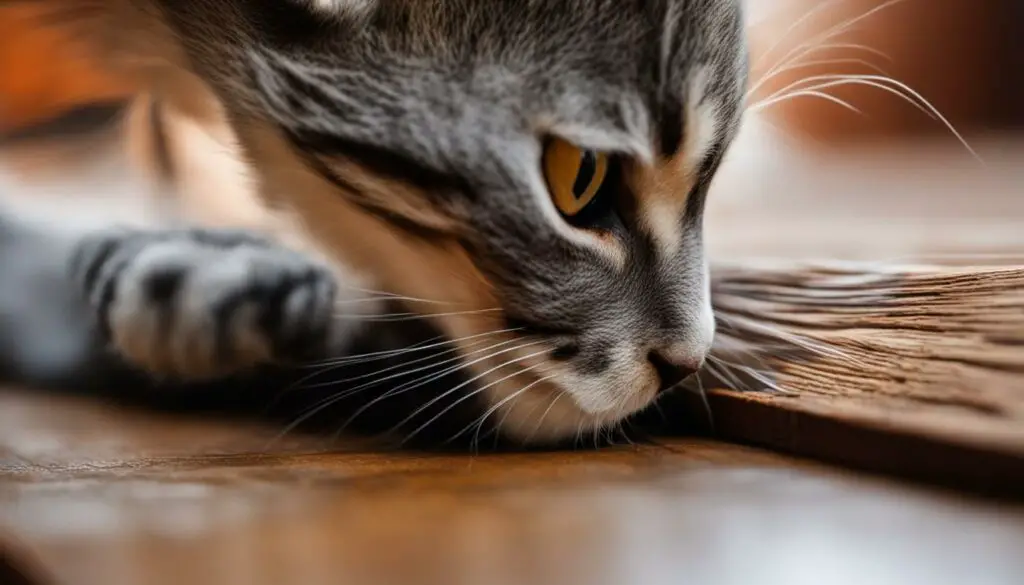
Why Do Cats Scratch When Their Owners Come Home?
Cats running to scratch when you come home is a common behavior that can be attributed to their communication tactics and excitement. While some cats may exhibit different behaviors to show their enthusiasm, scratching is a way for them to release emotions and express their happiness towards their owners.
“The scratching behavior is my cat’s way of telling me ‘I’m delighted you’re back!’ It’s their unique way of communication,” says Dr. Sarah Adams, a renowned veterinarian.
The scratching action not only allows cats to communicate their excitement but also helps them stretch their muscles. By providing an appropriate scratching post nearby, you can redirect their scratching behavior to a suitable location and ensure that your furniture remains scratch-free.
Remember, when your cat runs to scratch once you get home, it’s a sign of their love and excitement. Embrace their enthusiastic greeting and strive to provide them with the love and care they deserve.
What Can My Cat Be Excited About, Exactly?
When your cat runs to scratch once you get home, it’s a sure sign of excitement and happiness. But what exactly is your furry friend excited about? Cats can find joy in a variety of things, and understanding their sources of excitement can help you provide the best care and strengthen your bond with them.
One of the main things that can excite your cat is petting. Cats love to be touched and stroked, and it brings them comfort and pleasure. Take a few moments to give your cat some gentle strokes and watch as they purr with delight. The physical contact not only makes them feel loved but also helps to reinforce the bond between you and your feline companion.
Playing is another activity that can get your cat excited. Whether it’s chasing a toy mouse or engaging in a game of hide-and-seek, playtime provides mental and physical stimulation for your cat. It allows them to satisfy their natural hunting instincts and expend energy. Spend some quality time engaging in interactive play with your cat to keep them entertained and happy.
Lastly, food can be a significant source of excitement for cats. The anticipation of a delicious meal can make your cat eager and enthusiastic. Mealtimes are essential moments for your feline friend, so make sure you provide them with nutritious and tasty food that they enjoy. The satisfaction they get from a satisfying meal can contribute to their overall happiness and well-being.
| Excitement Triggers | Examples |
|---|---|
| Petting | Stroking their fur, scratching their favorite spots |
| Playing | Chasing toys, interactive play sessions |
| Eating | Providing tasty and nutritious meals |
Understanding what excites your cat is crucial in creating a harmonious and fulfilling relationship. By catering to their need for petting, play, and delicious meals, you can ensure they lead a happy and contented life. So go ahead, shower your feline companion with love, engage them in play, and provide them with their favorite meals. You’ll see their excitement and joy shine through every day.
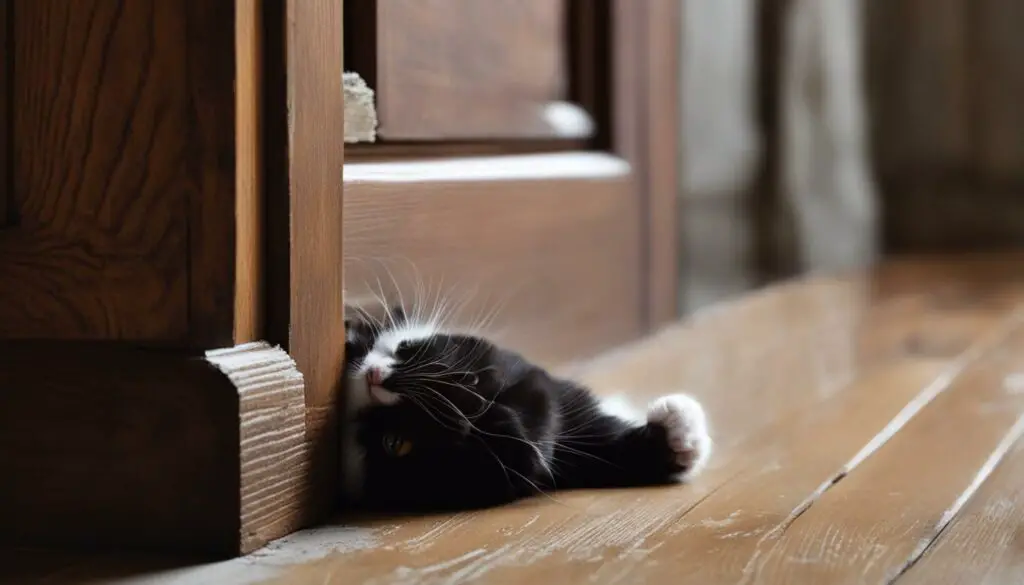
What Should I Do About the Scratching?
Dealing with cat scratching is an important aspect of being a cat owner. Instead of trying to stop the scratching altogether, it is essential to respond to your cat’s needs and redirect their behavior in a positive way. This involves understanding why they scratch and providing suitable alternatives.
When your cat scratches out of excitement, it is crucial to figure out what they are seeking. Do they want attention, playtime, or food? Observing their behavior and responding appropriately can reinforce their positive behavior. Remember to show them love and care while redirecting their scratching behavior.
Providing your cat with suitable scratching options is also essential. Choose a scratching post or mat that fits their preferences, whether they prefer a vertical or horizontal surface. Having multiple scratching posts, ideally near their favorite spots, can ensure they have suitable outlets for their scratching behavior.
Showing Love and Care while Redirecting Scratching Behavior
Redirecting your cat’s scratching behavior requires patience and understanding. Avoid punishing them for scratching inappropriately, as this can lead to stress and anxiety. Instead, focus on providing suitable alternatives and reinforcing positive behavior.
Take the time to play with your cat, using interactive toys that stimulate their hunting instincts. Engage in daily interactive play sessions to provide exercise and mental stimulation, which can help reduce their desire to scratch excessively. Additionally, consider providing scratching posts that are covered in materials that appeal to your cat, such as sisal or carpet.
| Do’s | Don’ts |
|---|---|
|
|
Remember, responding to your cat’s needs with love and care is key to addressing their scratching behavior. By providing suitable alternatives, engaging in interactive play, and creating a positive environment, you can help redirect their scratching behavior and strengthen your bond with them.
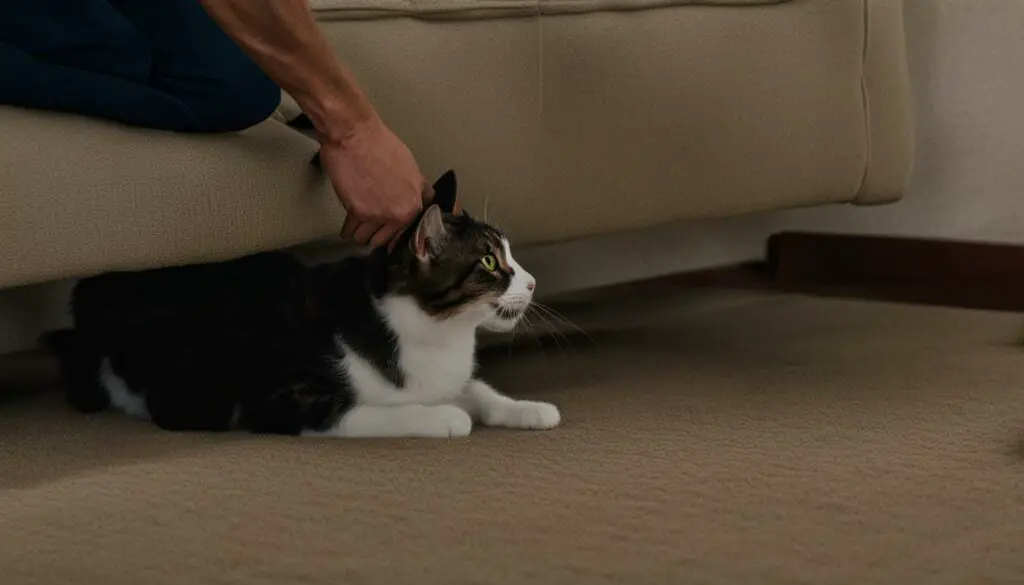
What Other Affection Gestures Might I Be Missing?
While scratching is a common behavior for cats, it’s important to recognize that they also show affection in various other ways. Understanding these subtle gestures can help you deepen your bond with your feline friend. Here are some affectionate behaviors that you might be missing:
Purring
Purring is a classic sign of contentment and relaxation in cats. It’s their way of expressing happiness and comfort. Pay attention to when your cat purrs, as it’s a clear indication that they are feeling loved and secure.
Meowing
Cats use meowing as a form of communication with humans. They may meow to greet you, ask for attention, or indicate their needs, such as wanting food or playtime. Responding to their meows with affection and understanding can strengthen your bond.
Blinking
When your cat blinks slowly at you, it’s a sign of trust and love. This behavior is often referred to as a “cat kiss.” By blinking back at your cat, you can reciprocate their affection and build a deeper connection.
Grooming
Cats groom themselves as a way to keep clean and show affection. If your cat licks you or gently nibbles your hand, they are extending their grooming behavior as a sign of love and belonging.
Rubbing Against Legs
When your cat rubs against your legs, they are marking you with their scent and showing that they consider you part of their territory. It’s a display of trust and affection, as they are claiming you as their own.
Showing Belly
When a cat shows you their belly, it’s a vulnerable and trusting gesture. It means they feel safe and comfortable around you. While it may be tempting to give their belly a rub, not all cats enjoy being touched there, so be sure to pay attention to their body language.
Understanding and acknowledging these affectionate gestures will help you strengthen the bond with your furry companion. Remember to respond with love and care to foster a loving relationship with your cat.
Why Do Cats Scratch?
Cats scratch for a variety of reasons, driven by their instinctual behaviors. Understanding these reasons can help you provide appropriate outlets for your cat’s scratching behavior. Let’s explore the main reasons behind cat scratching:
1. Exercise:
One of the primary reasons cats scratch is to stretch and exercise their muscles. Scratching helps them maintain flexibility and strength in their forelimbs and spine muscles. It’s essential to provide your cat with suitable scratching surfaces, such as a sturdy scratching post, to encourage regular exercise.
2. Territory Marking:
Scratching serves as a way for cats to mark their territory. By leaving scratch marks and scent from their sweat and scent glands, cats communicate their presence to other animals. This territorial marking behavior helps them feel secure in their environment.
3. Instinctual Behavior:
Scratching is an innate behavior in cats. It is deeply rooted in their instinctual nature and serves multiple purposes. Cats have a natural urge to scratch, which helps them release tension, anxiety, and even aggression. Providing appropriate scratching options can help channel and redirect this instinctual behavior in a positive way.
By understanding why cats scratch, you can create a cat-friendly environment that caters to their natural needs. Whether it’s providing scratching posts for exercise, strategically placing them to mark territory, or redirecting their instinctual behavior, meeting these needs will help maintain a harmonious relationship with your feline friend.
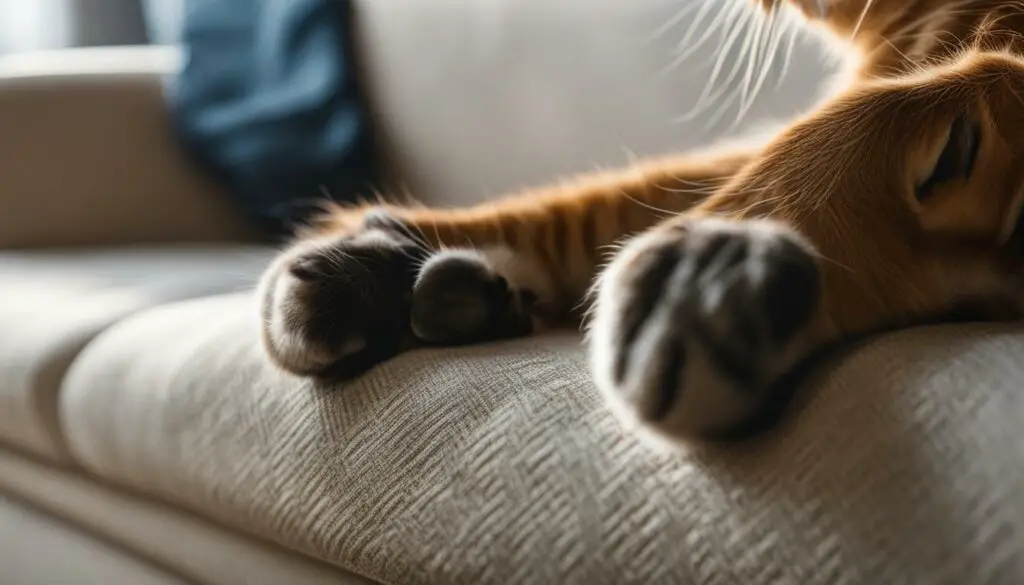
How to Stop Inappropriate Cat Scratching
Preventing your cat from scratching inappropriately requires redirecting their behavior and providing suitable alternatives. By understanding their needs and preferences, you can effectively address their scratching habits and maintain a harmonious environment.
Redirecting Scratching Behavior
When you notice your cat scratching where they shouldn’t, it’s essential to redirect their attention to a more appropriate scratching surface. Encourage them to use a scratching post or mat by placing it near their favorite scratching areas. You can also gently guide their paws onto the post to show them that it’s an acceptable alternative.
Additionally, consider using deterrents, such as double-sided tape or aluminum foil, on furniture or other off-limits surfaces. Cats dislike the texture and will likely avoid scratching those areas. Gradually, they will learn to associate the scratching post or mat as the preferred place for their scratching needs.
Providing Scratching Posts
To effectively prevent inappropriate scratching, provide your cat with multiple scratching posts throughout your home. It’s crucial to choose posts that suit your cat’s preferences, whether they prefer vertical or horizontal surfaces. Experiment with different materials, such as sisal or cardboard, to find the texture your cat enjoys.
Place the scratching posts in strategic locations near your cat’s favorite spots. If they tend to scratch furniture or door frames, position a post nearby. By providing accessible and appealing scratching options, you can redirect their behavior while honoring their natural instincts.
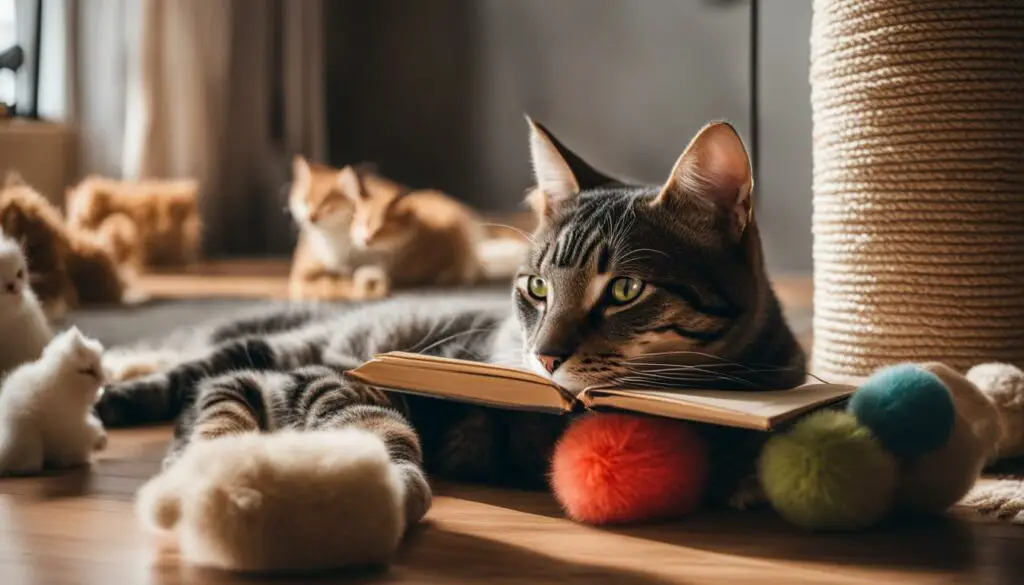
Summary
Preventing inappropriate scratching involves redirecting your cat’s behavior and providing suitable scratching posts. By guiding their attention to appropriate surfaces and offering appealing alternatives, you can discourage them from scratching furniture and maintain a happy and well-behaved feline companion.
Remember, patience and positive reinforcement are key when addressing your cat’s scratching habits. Avoid punishment or harsh actions, as these can lead to fear or anxiety in your cat. Instead, show them love and care while providing them with suitable outlets for their natural scratching behavior.
Get a Scratching Post or Mat
If you want to prevent your cat from scratching your furniture and carpets, providing them with a suitable scratching post or mat is essential. These scratching options give your cat a designated place to satisfy their natural urge to scratch and save your belongings from damage. When choosing a scratching post or mat, consider your cat’s preferences and behavior.
Choosing Suitable Scratching Surfaces
Cats have individual preferences for scratching surfaces, so it’s important to choose options that appeal to them. Some cats prefer vertical scratching surfaces like posts, while others prefer horizontal options like mats. Observe your cat’s scratching behavior to determine their preference.
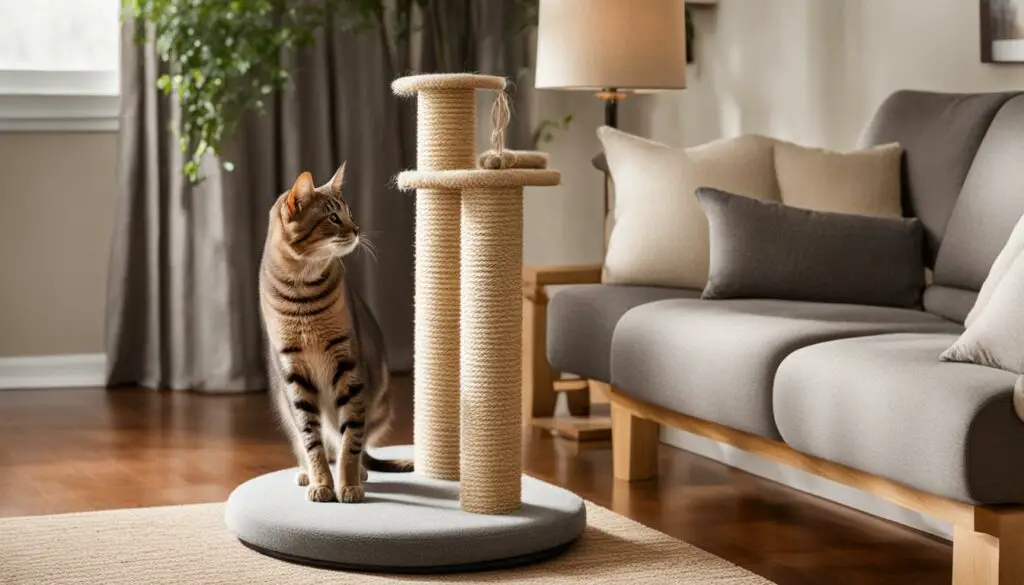
Providing Multiple Scratching Posts
Having multiple scratching posts throughout your home can increase the likelihood that your cat will use them. Place the posts in areas where your cat spends a lot of time or near their favorite scratching spots. This ensures that there is always a scratching option conveniently available for your cat.
Incorporating scratching posts or mats into your cat’s environment is an effective way to redirect their scratching behavior. By providing suitable scratching surfaces and multiple options, you can promote healthy scratching habits and protect your furniture and carpets from damage.
Think About Where Your Cat is Scratching
When it comes to redirecting your cat’s scratching behavior, it’s essential to observe where they tend to scratch the most. By understanding their preferred scratching areas, you can strategically place a scratching post or mat nearby to encourage them to use it instead. This not only protects your furniture and belongings but also provides a suitable outlet for their natural behavior.
For example, if your cat often scratches the corner of your couch, consider placing a scratching post right next to it. By doing so, you create a more appealing alternative for them. It’s important to choose a scratching post that matches your cat’s preferences, whether they prefer a vertical or horizontal surface. This targeted approach to redirecting their scratching behavior can yield positive results.
Another effective technique is to consider the proximity of the scratching post to your cat’s favorite scratching areas. If they have a particular spot where they often scratch, place a scratching post directly next to it. This way, the scratching post is easily accessible, and your cat can quickly transition from their preferred spot to the post.
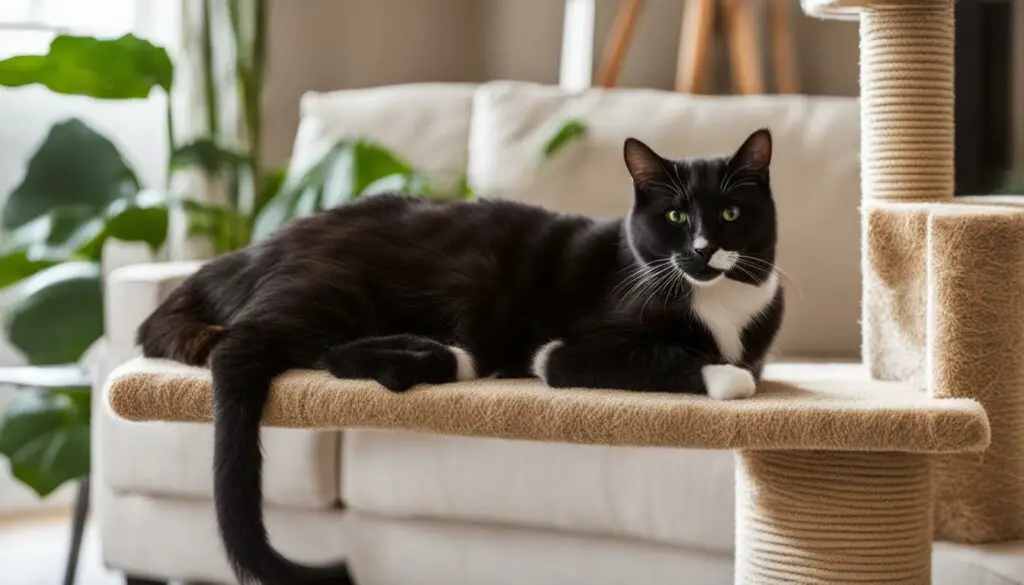
Example of Strategic Placement of Scratching Post
| Favorite Scratching Area | Strategic Placement of Scratching Post |
|---|---|
| The corner of the couch | Right next to the corner |
| The edge of the carpet | Directly adjacent to the carpet |
| The wall near their bed | Close to their bed against the wall |
By strategically placing a scratching post near your cat’s favorite scratching areas, you provide them with a clear alternative. This helps redirect their scratching behavior and encourages them to use the scratching post instead of your furniture or other inappropriate surfaces.
Remember, redirecting your cat’s scratching behavior requires patience and consistency. Always reward and praise your cat when they use the scratching post, and avoid punishing them for inappropriate scratching. By using positive reinforcement and providing suitable alternatives, you can help your furry friend develop healthy scratching habits while maintaining a harmonious home.
Conclusion
Understanding why your cat scratches and how to address their behavior is essential for strengthening your bond with them. By providing suitable scratching options and responding to their needs with love and care, you can redirect their behavior and ensure a harmonious relationship.
Cat scratching is a natural behavior that serves various purposes, including exercise, territory marking, and instinctual urges. By recognizing the reasons behind their scratching, you can provide appropriate outlets for their behavior and prevent inappropriate scratching.
Remember to have scratching posts or mats available, choose ones that fit your cat’s preferences, and consider their preferred scratching locations. Patience is key, and punishing your cat for inappropriate scratching is not effective. Instead, redirect their behavior by providing suitable alternatives near their favorite scratching areas.
By understanding cat scratching and responding to it with love and care, you can meet your cat’s needs and strengthen your bond. Show them affection through petting, playing, and providing food, and be attentive to their communication cues. With a little patience and the right approach, you can ensure a happy and scratch-free environment for both you and your beloved feline friend.
FAQ
Why does my cat scratch when I come home?
Cats may scratch when you come home as a way to communicate their excitement and happiness.
Why do cats scratch?
Cats scratch for various important reasons, including marking their territory, maintaining nail hygiene, exercising their muscles, and releasing anger.
How do cats use scratching to mark their territory?
Cats leave scratch marks and a unique smell produced by their sweat and scent glands when they scratch, which helps them communicate with other cats and feel at home in their environment.
Why is nail hygiene important for cats?
Scratching allows cats to remove the outer husk of their claws, maintain their nails, and check for any diseases or injuries in the claw area.
How does scratching help cats exercise their muscles?
When cats scratch, they stretch their forelimbs and spine muscles, promoting muscle strength and flexibility.
How does scratching help cats release anger?
Scratching can serve as a way for cats to release anger, tension, and anxiety, as well as to communicate their emotions to their owners.
Why do cats run to scratch once I get home?
While there are not many studies on this specific behavior, it is believed that cats run to scratch when you come home as a way to communicate their excitement and happiness.
What can my cat be excited about when I come home?
Cats may be excited to see you for various reasons, such as wanting attention, playtime, or anticipating being fed.
How should I respond to my cat’s scratching?
It is important to respond to your cat’s needs by figuring out what they are seeking, whether it’s attention, playtime, or food, and providing that for them. Showing them love and care will reinforce their positive behavior.
What other gestures of affection might my cat be showing?
Cats show affection in various ways, including purring, meowing, blinking slowly, grooming, rubbing against your legs, and showing their belly.
What are the main reasons behind cat scratching?
Cats scratch for exercise, to mark their territory, and out of instinct.
How can I stop my cat from inappropriate scratching?
Preventing inappropriate scratching involves providing your cat with suitable alternatives, such as scratching posts or mats, and avoiding punishment.
What should I consider when getting a scratching post or mat?
Choose a scratching post or mat that fits your cat’s preferences, whether they prefer a vertical or horizontal surface. Having multiple scratching posts, ideally near their favorite spots, can ensure they have suitable outlets for their scratching behavior.
How can I redirect my cat’s scratching behavior?
Observing where your cat is scratching can help you redirect their behavior effectively. Consider placing a scratching post near their favorite scratching areas, such as their bed or furniture.
How can I strengthen my bond with my cat?
Understanding why your cat scratches and how to address their scratching behavior can help strengthen your bond with them. By providing suitable scratching options, responding to their needs, and showing them love and care, you can redirect their behavior and ensure a harmonious relationship.
Source Links
- https://adventurouscat.com/why-does-my-cat-run-to-the-scratching-post-when-i-come-home/
- https://us.feliway.com/blogs/news/why-do-cats-scratch-3-reasons-and-how-to-stop-it
- https://vcahospitals.com/know-your-pet/cat-behavior-problems—scratching-behavior

